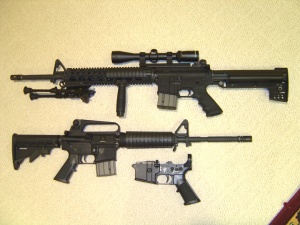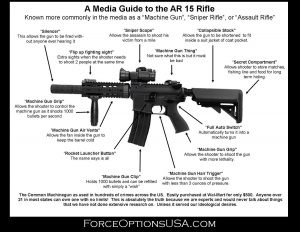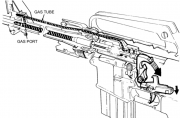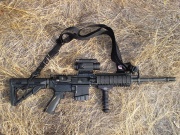Difference between revisions of "AR-15"
(→videos) |
|||
| (One intermediate revision by one user not shown) | |||
| Line 1: | Line 1: | ||
| − | {{gun | + | {{ start tab |
| + | | tab-1 = AR-15 | ||
| + | | link-1 = AR-15 | ||
| + | | tab-2 = Variants | ||
| + | | link-2 = AR-15/variants | ||
| + | | tab-3 = | ||
| + | | link-3 = | ||
| + | | tab-4 = | ||
| + | | link-4 = | ||
| + | | tab-5 = | ||
| + | | link-5 = | ||
| + | | border = 1px solid #808080 | ||
| + | | off tab color = #f0fff0 | ||
| + | | on tab color = #ffffff | ||
| + | | rounding = 0.5em | ||
| + | | tab alignment = | ||
| + | }}{{gun | ||
|name= Armalite Rifle 15 | |name= Armalite Rifle 15 | ||
|image= Stag2wi.jpg|300px|AR-15 SP1 | |image= Stag2wi.jpg|300px|AR-15 SP1 | ||
| Line 109: | Line 125: | ||
*[[6.5 Grendel]] (.264 cal) | *[[6.5 Grendel]] (.264 cal) | ||
*[[6.8 SPC]] (.270 cal) | *[[6.8 SPC]] (.270 cal) | ||
| + | *[[.30 Carbine]] | ||
*[[.300 Whisper]] | *[[.300 Whisper]] | ||
*[[7.62x39mm]] | *[[7.62x39mm]] | ||
Latest revision as of 14:34, 30 July 2015
| AR-15 | Variants |
| Armalite Rifle 15 | |
|---|---|

| |
| The AR-15 can come in many different varieties of size, options, and manufacturer | |
|
| |
| Type | Automatic / Semi-automatic rifle / Service rifle |
| Land of Origin | United States |
| Specifications | |
| Length | variable by barrel |
| Barrel length | 20 in (508 mm) standard 16 in (406 mm) 14.5 in (368 mm) |
| Weight | 2.27 kg - 3.9 kg (5.5 - 8.5 lb) |
| Cartridge | .223 Remington, 5.56 NATO |
| Action | Direct impingement / Rotating bolt |
| Rifling/Twist | 1:14 to 1:7 (see text) |
|
| |
| Rate of Fire | 800 rounds/min |
| Muzzle velocity | 975 m/s (3,200 ft/s) |
| Effective Range | 550 m (600 yd) |
| Feed | Various STANAG Magazines. |
| Sights | Adjustable front and rear iron sights |
| Service History | |
| In service | 1958 to present (variants) |
| Production History | |
| Designer | Eugene Stoner |
| Design Date | 1957 |
| Manufacturer | originally ArmaLite & Colt |
| Unit Cost | USD$850-$1200 (avg.) |
| Produced | 1958-present |
| Variants | see below |
The AR(Armalite Rifle)-15 is a widely owned, lightweight, air-cooled, gas-operated, magazine fed, semi-automatic, centerfire, shoulder-fired rifle. The original ArmaLite/Colt AR-15 was a selective-fire prototype submitted for consideration as a military infantry rifle, which was later adopted as the M16, and is distinguished from later civilian-model AR-15 rifles marketed by Colt Firearms. Currently, AR-15 is a generic term for a civilian semi-automatic rifle similar to the military M16/M4-type weapons.
The AR-15 consists of separate upper and lower receiver assemblies, which are attached with two through-pins and can be quickly interchanged with no tools. The lower receiver (because it bears the weapon's serial number and fire control group) is itself regulated as a firearm. However, the upper receiver assembly is simply considered a part (in most jurisdictions), and may be purchased and mail-ordered in most locations with no restrictions. This is an attractive feature for users because it allows a number of upper receivers (often in different calibers) to be interchanged with the same lower receiver.[1] However, one must be thoroughly familiar with firearms laws before doing this as it is possible to make an illegal configuration.[2]
Standard AR-15 rifles accept detachable magazines of widely varying capacities (Including, amongst others, 10, 20, or 30 round box magazines, or 100 round drums), and have a pistol grip that protrudes beneath the stock. AR-15 rifles are highly configurable and customizable. They are commonly fitted with several accessories such as bipods, collapsing stocks, threaded barrels for the attachment of a flash suppressor, and a rail system for the attachment of vertical grips, flashlights, laser sights, telescopic sights and other accessories. The most common bipod is the folding type. There is also The vertical grip with a bipod release. Barrels can come in chrome and stainless steel. The steel barrel tends to be more accurate while the chrome tends to be more durable. You can also get barrels with a various rates of twist (see below). The smaller the ratio the faster the bullet spin before coming out the barrel; the specific rate of twist is tailored to the desired bullet weight (heavier/longer bullets require more twist). AR-15s can also be assembled with a suppressor.
Contents |
[edit] History

The AR-15 is based on the 7.62 mm AR-10, designed by Eugene Stoner of the Fairchild ArmaLite corporation.[3] The AR-15 was developed as a lighter, 5.56 mm version of the AR-10. The "AR" in AR-15 comes from the ArmaLite name, not "assault rifle" as is commonly believed; ArmaLite's AR-1, AR-5, and some subsequent models were bolt action rifles, and there are shotguns and pistols whose model numbers also include the "AR" prefix.[3]
ArmaLite sold its rights to the AR-10 and AR-15 to Colt in 1959. Colt marketed the AR-15 rifle to various military services around the world, including the U.S. Air Force, Army, and Marine Corps. The AR-15 was eventually adopted by the United States military under the designation M16. However, Colt continued to use the AR-15 trademark for its semi-automatic variants (AR-15, AR-15A2) marketed to civilian and law-enforcement customers. The original AR-15 was a very lightweight weapon, weighing less than 6 pounds with empty magazine, though later heavy-barrel versions of the civilian AR-15 can weigh upwards of 8.5 lbs.
Today the civilian-model AR-15 and its variations are manufactured by many companies and have captured the affection of sport shooters and police forces around the world due to their accuracy and modularity. (Please refer to the M16 article for a more complete history of the development and evolution of the AR-15 and derivatives.)
The trademark "AR15" or "AR-15" is registered to Colt Industries, which maintains that the term should only be used to refer to their products. Other manufacturers make AR-15 clones marketed under separate designations, although colloquially these are sometimes also referred to by the term AR-15.
Some notable features of the AR-15 include:
- Aircraft grade aluminum receiver
- Modular design allows for a variety of accessories and makes repair easier
- Small caliber, accurate, high velocity round
- Synthetic stock and grips do not warp or splinter
- Front sight adjustable for elevation
- Rear sight adjustable for windage and elevation
- Wide array of optical devices available in addition to or as replacements of iron sights
- A direct impingement gas system
Semi-automatic and full auto variants of the AR-15 are effectively identical in appearance. Automatic variants have a rotating selective fire switch, allowing the operator to select between three modes: safe, semi-automatic, and either automatic or three round burst, depending on model. Civilian AR-15 models usually do not have three-round burst or automatic settings on the fire selector. In semi-automatic only variants, the selector only rotates between safe and semi-automatic.
[edit] Operating mechanism

The mechanism of operation for the rifle is known as direct gas impingement. Gas is tapped from the barrel as the bullet moves past a gas port located above the rifle's front sight base. The gas rushes into the port and down a gas tube located above the barrel. The gas tube runs from the front sight base into the AR-15's upper receiver. Here, the gas tube telescopes into a “gas key” which accepts the gas and funnels it into the bolt carrier. The movement of gas into the bolt carrier forces the bolt and carrier backwards in a line with the stock of the rifle. As the bolt carrier moves towards the butt of the gun, the bolt begins to turn and unlock from the barrel extension. Once the bolt is fully unlocked it begins rearward movement along with the bolt carrier. The cam pin is responsible for the bolt's rotation as it follows a groove cut into the carrier that twists and forces the bolt to unlock. Once the bolt is unlocked, the bolt carrier and bolt continue to move towards the butt of the gun and the chambered casing is extracted and ejected out the side of the upper receiver.
A return spring located behind a buffer then pushes the bolt carrier back towards the chamber. A groove machined into the upper receiver traps the cam pin and prevents it and the bolt from rotating into a closed position. The bolt's locking lugs then push a fresh round out of the magazine, up the feed ramps and into the chamber. As the bolt's locking lugs move past the barrel extension, the cam pin is allowed to twist into a pocket milled into the upper receiver. This twisting action follows the groove cut into the carrier and forces the bolt to twist and “lock” into the barrel’s extension.
[edit] Variants
- see also: AR-15 variants
The AR15 rifle is available in a wide range of configurations from a number of manufacturers. These configurations range from short carbine-length models with features such as adjustable length stocks and optical sights, to heavy barrel models.
Aftermarket upper receivers that incorporate barrels of different weights and lengths, and handle different caliber ammunition, abound for this rifle. They are very easily installed, due to the rifle's modular design. These calibers include:
Pistol calibers:
Rifle calibers:
|
|
When installing a new complete upper receiver, particularly one designed to handle a different caliber of ammunition (i.e. other than .223 Remington or 5.56 x 45 mm NATO), some modification to the contents of the lower receiver may also be required, depending on the particular conversion. For example, a conversion to 9mm typically would involve the installation of a magazine well block (to accommodate a typical 9mm magazine, such as Uzi or Colt SMG), replacing the .223 hammer with one designed for 9mm ammunition, and depending on your original stock, replacing the buffer, action spring and stock spacer with those designed for your new 9mm AR-15 configuration.
Earliest models had a 1:14 rate of twist, which was changed to 1:12 for original 55 grain (3.6 g) bullets. The 1:14 rate of twist showed to be unstable in colder temperatures. Most newer configurations use 1:9 and 1:7 twist rates. There is much controversy and speculation as to how differing twist rates affect ballistics and terminal performance with varying loads, but heavier projectiles tend to perform better with faster rifling rates. Additionally, the various non .223 / 5.56 calibers have their own particular twist rate, such as 1:10 for 6.8x43mm SPC and 7.62x39mm, and 1:12 for .308 Winchester.
Standard issue magazines are 20 or 30 round staggered-column magazines, traditional box magazines also exist in 40 and 45 round capacities, and usable magazines have been constructed from a variety of materials including steel, aluminum, and high-impact plastics. Drum magazines with 90 and 100 round capacities also exist, such as Beta C-Mags. Low-capacity magazines, usually of a 5 or 10 round capacity, are available to comply with some areas' legal restrictions, hunting and because larger magazines can inhibit shooting from a benchrest.
[edit] Legal status in the United States

In the United States, variants with certain features such as collapsible stocks, flash suppressors, and bayonet lugs were prohibited for sales to civilians during the period 1994-2004 by the Violent Crime Control and Law Enforcement Act of 1994, under the provision known as the Assault Weapons Ban. Those that were manufactured with those features were stamped, "Restricted Military/Government/Law Enforcement/Export Only" as well as the accompanying high capacity magazines. Since the expiration of the Federal AWB in September of 2004,[4] these features are now legal in most states.[5]
The 2000 Assault Weapons ban in the state of California sparked a renewed interest in the AR-15 rifle. It is estimated that some 70,000 California Legal AR-15s are in existence in that state. Adding the upper receiver of a standard AR-15 or equivalent with an AR-15 equivalent lower receiver which has not been specifically banned by statute or regulation, and that has a fixed 10 round magazine will render the firearm "California legal." In such a configuration, the user could add otherwise prohibited features such as a telescoping stock and pistol grip. The magazine is not detachable, so to load the rifle the shooter must pull the rear takedown pin, hinge the upper receiver on the front pivot pin, and load the now exposed magazine either with a stripper clip or by hand, then close. Popular lower receivers for this purpose are manufactured by Stag Arms, Fulton Armory, Dane Armory, Mega, and Ameetec. By California law if the magazine requires a tool to remove it, that changes the classification of the firearm. A tool called the "Bullet Button" is gaining in popularity: the bullet button works by replacing the magazine release button with a hollow shell that protrudes a short distance from the lower; the shooter must then push the inset pin to activate the mag release, doing so requires a tool e.g., a bullet, hence the name. Stag makes a lower receiver called the STAG-15 which is considered an "off-list" receiver by the CA DOJ and is legal. As of December 2006, Doublestar, Stag Arms, CMMG, Spikes Tactical, and MEGA all qualify as "off-list" lowers in the state of CA. There is also one model made by Colt, the CAR-A3 HBAR Elite, that was never banned by name, and thus still legal to own in California provided it has the correct configuration. This receiver can be made into a full rifle if the following requirements are met: the receiver has a fixed magazine with no more than 10 cartridges - in which case the rifle may have pistol grips, folding or collapsing stocks, etc.; or, the receiver may have a detachable magazine but may not possess any sort of attachment such as pistol grips, folding or collapsing stocks, etc.
[edit] Concerns
With the plethora of manufacturers of complete weapons and aftermarket barrels, there is a potential hazard associated with chamber specifications. Both civilian (SAAMI) specification .223 Remington and 5.56 mm NATO are available. Though both chambers typically accept both types of ammunition, the firing of military specification ammunition in civilian specification chambers can produce chamber pressures greater than the barrel is designed to handle. The most common result of firing military 5.56x45mm ammunition in a .223 Remington chamber is that the primer can be forced out of the case by chamber pressure, often resulting in the primer becoming lodged somewhere in the action of the rifle, and disassembly of the rifle is often necessary to remove the jammed primer. [6] Military specification chambers typically have a more open throat area producing less pressure and can handle both types of ammunition.
A few AR15 manufacturers incorporate the use of a hybrid chamber specification known as the Wylde chamber. Designed by and named after Bill Wylde, this chambering was created for High Power shooters after the 80 grain .224" bullets became popular. While the Wylde chamber allows for optimal seating depth of 80 grain bullets over .223 Remington and 5.56 NATO, it is capable of accepting both ammunition types. The Wylde chamber is used by a few manufacturers who sell "National Match" configuration AR-15 rifle, barrels, and upper receivers.
The type of chamber, manufacturer, and rifling twist in inches is typically found stamped into the barrel in front of the front sight assembly.
An additional point of concern in the design is the inertial firing pin. A lightweight firing pin rides in a channel inside the bolt unrestrained. When the bolt locks forward during loading, the firing pin typically rides forward and impacts the chambered round's primer. In military specification ammunition and quality civilian ammunition, this is not normally enough to fire the round and only leaves a small "ding" on the primer. With more sensitive primers or improperly seated primers, this can cause a slamfire during loading.[7]
Another type of malfunction, Hammer Follow, is also a potential problem for AR platform weapons. In one case, David Olofson, an Army Reservist with 16 years in the US Army, loaned to a prospective buyer an AR-15 rifle which was found to malfunction in such a way that it would fire multiple rounds on a single trigger pull. After law enforcement intervention, David Olofson was charged with and found guilty of illegally transferring a machinegun, and was sentenced to thirty months in prison.[8]
[edit] Manufacturers
[edit] Resources
[edit] manuals
| Gun Owners' Resource has the following relevant documents available for free download for the AR-15 and/or its variants: |
- Colt AR-15 Operator's Manual (PDF)
- Colt AR15 Match Target Operator's Manual (PDF)
- Colt AR15 Sporter Manual (PDF)
- Colt AR15 to 22lr Conversion Manual (PDF)
[edit] videos
[edit] diagrams
The following diagrams are also available for reference:
AR15 upper receiver parts
[edit] See also
[edit] References
- ↑ U.S. Military Small Arms Ammunition Failures and Solutions, GK Roberts, NDIA Dallas, TX, 21 May 2008 http://www.dtic.mil/ndia/2008Intl/Roberts.pdf
- ↑ Gunsmithing Rifles, Patrick Sweeney (1999) p. 286
- ↑ 3.0 3.1 A Historical Review of Armalite ArmaLite, Inc.
- ↑ ATF Online - Firearms FAQs (section O, question 1) ATF
- ↑ ATF Online - Firearms FAQs (section O, question 11) ATF
- ↑ ArmaLite, Inc. Technical Note - 5.56 NATO vs SAAMI .223 Chambers ArmaLite, Inc.
- ↑ ArmaLite, Inc. Technical Note - Prevention of Slamfires ArmaLite, Inc.
- ↑ Knox, Jeff (2008-02-02). "The Accidental Felon". The Firearms Coalition.
[edit] External links
- Modern Firearms article
- Eugene Stoner AR15
- Terminal Ballistics of AR15
- AR15/M16 Parts Comparison
- Virtual AR-15 Builder
| The AR-15 is part of a series of pages on guns derived from Stoner's AR-10 and AR-15. | |
|---|---|
| AR-10 • AR-15 • AR-57 • AR-831 • C7/C8 • CAR • CAR-15 • Colt 9mm SMG • CQ • CQBR • GatMalite • GPC • HK416 • HK417 • MSSR • MKA 1919 • M110 • M16 • M16K • M231 • M27 • M4 • M4A2/A3 • M6 • REC7 • Recon Rifle • SDM-R • SAM-R • Shrike • SPR • SR-25 • SR-47 • SR-556 • T-14 • T-15 • T-16 • T-17 • T65 • T86 • T91 | |









